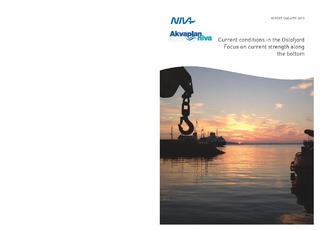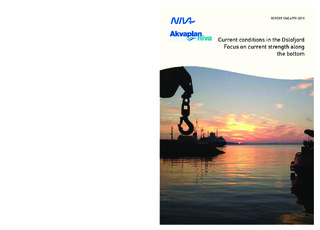| dc.contributor.author | Staalstrøm, Andre | |
| dc.contributor.author | Ghaffari, Peygham | |
| dc.contributor.other | Staalstrøm, Andre - Project manager | |
| dc.date.accessioned | 2015-10-21T07:46:18Z | |
| dc.date.accessioned | 2015-10-22T10:38:46Z | |
| dc.date.available | 2015-10-21T07:46:18Z | |
| dc.date.available | 2015-10-22T10:38:46Z | |
| dc.date.issued | 2015 | |
| dc.identifier | 6799 | |
| dc.identifier.citation | NIVA-rapport. 57 p. Norsk institutt for vannforskning, 2015 | nb_NO |
| dc.identifier.isbn | 978-82-577-6534-7 | |
| dc.identifier.issn | 1894-7948 | |
| dc.identifier.uri | http://hdl.handle.net/11250/2357700 | |
| dc.description.abstract | The objective of this project has been to assess how strong the current conditions near the bottom can be in extreme cases. Extreme
value analysis has been applied to current observations near the bottom at six stations in the Oslofjord. The length of the observation
period was up to seven weeks, from mid-September to the end of November 2014. The result from the extreme value analysis was
multiplied with safety factor of 1.5 to account for possible additive effects of barotropic and baroclinic forcing. The strongest currents
were found where the fjord is relatively narrow, in the Drøbak Sound. This was stations Filtvedt (Km1) and Brenntangen (Kn2), where
the extreme value current with a return period of 50 years multiplied with the safety factor was 75 and 99 cm/s, respectively. A more
realistic extreme value for these two stations is the result from the extreme value analysis with a return period of 10 years, which were
45 and 59 cm/s for the two stations respectively. The stronger current in the more narrow part of the fjord can be explained by a
stronger tidal signal due to the fjord geometry. In both the two transects across the fjord, it was the shallowest stations that had the
highest current velocities. This can be explained by the fact that the horizontal pressure gradient has a tendency to decrease with depth. | nb_NO |
| dc.description.sponsorship | Statnett | nb_NO |
| dc.language.iso | eng | nb_NO |
| dc.publisher | Norsk institutt for vannforskning | nb_NO |
| dc.relation.ispartofseries | NIVA-rapport;6799 | |
| dc.rights | Navngivelse-Ikkekommersiell-DelPåSammeVilkår 3.0 Norge | * |
| dc.rights.uri | http://creativecommons.org/licenses/by-nc-sa/3.0/no/ | * |
| dc.title | Current conditions in the Oslofjord. Focus on current strength along the bottom | nb_NO |
| dc.type | Research report | nb_NO |
| dc.date.updated | 2015-10-21T07:46:17Z | |
| dc.rights.holder | Norsk institutt for vannforskning / Norwegian institute for water research | |
| dc.subject.nsi | VDP::Matematikk og naturvitenskap: 400 | nb_NO |
| dc.subject.nsi | VDP::Mathematics and natural scienses: 400 | nb_NO |
| dc.source.pagenumber | 57 | nb_NO |
| dc.identifier.cristin | 1282191 | |
| dc.subject.keyword | Analyse for ekstreme verdier / Extreme value analysis | |
| dc.subject.keyword | Fjorddynamikk / Fjord dynamics | |
| dc.subject.keyword | Oslofjorden / Oslo fjord | |
| dc.subject.keyword | Strømmålinger / Current measurements | |
| dc.relation.project | 14290 | nb_NO |



